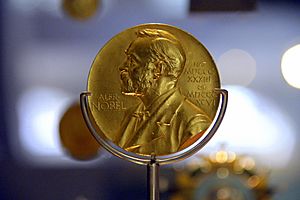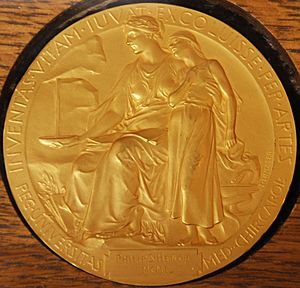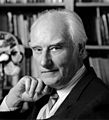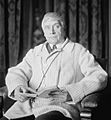Nobel Prize medal facts for kids
The Nobel Prize medal is a special gold medal given to people who win a Nobel Prize. These prizes are for amazing work in Chemistry, Literature, Peace, Physics, and Physiology or Medicine. They have been given out since 1901. There's also a medal for the Nobel Memorial Prize in Economic Sciences, which started in 1968.
Each medal shows a picture of Alfred Nobel on the front. The medals for chemistry, literature, physics, and medicine have the same picture of Nobel. The peace and economics medals have a slightly different picture. Erik Lindberg designed the medals for chemistry, literature, physics, and medicine. The peace prize medal was designed by Gustav Vigeland, and the economics prize medal by Gunvor Svensson-Lundqvist.
These medals are made from 18-carat green gold and then covered with 24-carat gold. Most of them weigh about 175 grams (0.386 lb). The economics prize medal is a bit heavier at 185g.
Winners also get a special diploma that explains their achievements. They also receive money from the Nobel Foundation. People who vote for the prizes get smaller copies of the medals. The chemistry, literature, physics, and medicine prizes are sometimes called the 'Swedish medals'.
Contents
What the Medals Look Like

Every Nobel Prize medal has a picture of Alfred Nobel on its front side (called the obverse). The medals for Chemistry, Literature, Physics, and Physiology or Medicine all have the same front design. It shows Nobel and the years he was born and died. The Peace Prize and Economics Prize medals also show Nobel, but his portrait looks a little different.
The back side (called the reverse) of the chemistry, medicine, literature, and physics medals has the winner's name engraved on a small plate. For the peace and economics medals, the winner's name is engraved on the edge of the medal.
The very first Nobel winners in 1901 received temporary medals. The official gold medals were made later in 1902. This delay happened because each organization giving out a prize had to approve the designs.
From 1902 to 2010, the Swedish royal mint, Myntverket, made most of the medals. Since 2012, Svenska Medalj in Eskilstuna has made them, except for the peace prize medal, which is made in Norway.
Physics and Chemistry Medals
The medals for Physics and Chemistry look the same. The Royal Swedish Academy of Sciences gives them out. The back of these medals shows the Goddess of Nature, who looks like Isis. She comes out of clouds holding a cornucopia (a horn of plenty). The Genius of Science lifts a veil from Nature's face.
This medal was designed by Erik Lindberg. It has a Latin phrase: "Inventas vitam iuvat excoluisse per artes". This means "It is beneficial to have improved (human) life through discovered arts." This quote comes from an old Roman poem called the Aeneid by Virgil. The winner's name is written on a plate below the figures.
Physiology and Medicine Medals

The Nobel Prize in Physiology or Medicine medal is given by the Nobel Assembly at the Karolinska Institute. The back of this medal shows the 'Genius of Medicine'. She holds an open book and collects water from a rock to give to a sick girl.
This medal also has the Latin phrase: "Inventas vitam iuvat excoluisse per artes". The winner's name is on a plate below the figures. This medal was also designed by Erik Lindberg.
Literature Medals
The Nobel Prize in Literature medal is given by the Swedish Academy. The back of this medal shows a young man sitting under a laurel tree. He is listening to and writing down the song of a Muse (a goddess of inspiration).
Like the others, this medal has the Latin phrase: "Inventas vitam iuvat excoluisse per artes". The winner's name is on a plate below the figures. Erik Lindberg designed this medal too.
Peace Medals

The Nobel Peace Prize medal was designed by the Norwegian sculptor Gustav Vigeland in 1901. The picture of Alfred Nobel on this medal is different from the one on the other medals.
The back of the peace medal shows three men holding hands, showing a 'fraternal bond' (brotherhood). It has the Latin words 'Pro pace et fraternitate gentium', which means "For the peace and brotherhood of men". The edge of the medal has the year it was given and the winner's name.
Economic Sciences Medals
The medal for the Nobel Memorial Prize in Economic Sciences was designed by Gunvor Svensson-Lundqvist in 1968. The front of this medal shows Alfred Nobel and the words "Sveriges Riksbank till Alfred Nobels Minne 1968". This means "The Sveriges Riksbank, in memory of Alfred Nobel, 1968". Below this, there is a horn of plenty, which is a symbol of the Swedish central bank.
The winner's name is written on the edge of the medal. The back shows the symbol of the Royal Swedish Academy of Sciences, which is the North Star. This is the only Nobel medal that does not have a Latin quote on its back.
How Medals Are Made
The Nobel medals are made from 18-carat green gold and then covered with a layer of 24-carat gold. Before 1980, all medals were made from 23-carat gold. Most medals weigh about 175 grams (0.386 lb), but the economics medal weighs 185g. They are about 66 millimetres (2.6 in) wide and their thickness varies.
During World War II, the medals of two German scientists, Max von Laue and James Franck, were sent to Denmark for safety. When Germany invaded Denmark, a Hungarian chemist named George de Hevesy dissolved the medals in a special acid. He did this to prevent them from being taken by the Nazis. After the war, the gold was safely recovered from the acid, and new medals were made for the scientists.
Medals That Were Stolen
Sometimes, Nobel medals have been stolen. Here are a few examples:
- Ernest Hemingway's 1954 Literature medal was stolen in 1986 from a church in Cuba. It was later found.
- Rabindranath Tagore's 1913 Literature medal was stolen in 2004 from a museum in India. It is still missing.
- Ernest O. Lawrence's 1939 Physics medal was stolen in 2007 from a museum in California. It was found a few days later.
- Desmond Tutu's 1984 Peace medal was stolen from his home in 2007 but was recovered a week later.
- Kailash Satyarthi's 2014 Peace medal was stolen in 2017 and later found.
Medals That Were Sold
Some Nobel Prize winners or their families have sold their medals. Here are some examples:
- Norman Angell's 1933 Peace medal was sold in 1983 for about $12,000.
- Niels Bohr's 1922 Physics medal and August Krogh's 1920 Medicine medal were sold in 1940 to help raise money during World War II.
- Francis Crick's 1962 Medicine medal was sold in 2013 for $2.27 million. A part of the money went to a science institute.
- Carlos Saavedra Lamas's 1936 Peace medal was sold in 2014 for over $1.1 million.
- Dmitry Muratov's 2021 Peace medal was sold in 2022 for $103.5 million. The money was given to UNICEF to help children affected by the conflict in Ukraine.
- James Watson's 1962 Medicine medal was sold in 2014 for $4.8 million. He was the first living winner to sell his medal.
Images for kids

























